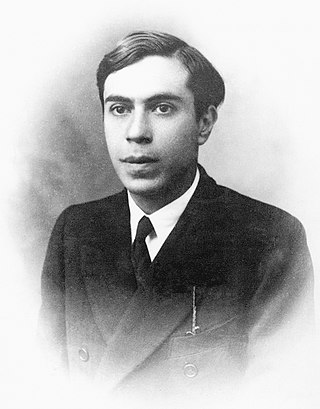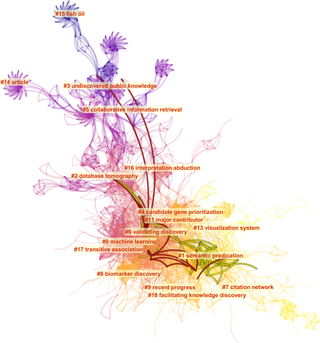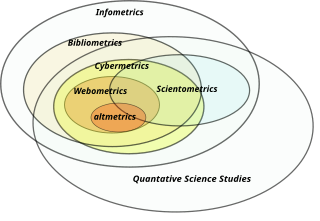Related Research Articles

The scientific method is an empirical method for acquiring knowledge that has characterized the development of science since at least the 17th century It involves careful observation, applying rigorous skepticism about what is observed, given that cognitive assumptions can distort how one interprets the observation. It involves formulating hypotheses, via induction, based on such observations; the testability of hypotheses, experimental and the measurement-based statistical testing of deductions drawn from the hypotheses; and refinement of the hypotheses based on the experimental findings. These are principles of the scientific method, as distinguished from a definitive series of steps applicable to all scientific enterprises.
Scientific misconduct is the violation of the standard codes of scholarly conduct and ethical behavior in the publication of professional scientific research.

A citation is a reference to a source. More precisely, a citation is an abbreviated alphanumeric expression embedded in the body of an intellectual work that denotes an entry in the bibliographic references section of the work for the purpose of acknowledging the relevance of the works of others to the topic of discussion at the spot where the citation appears.

Ettore Majorana was an Italian theoretical physicist who worked on neutrino masses. On 25 March 1938, he disappeared under mysterious circumstances after purchasing a ticket to travel by ship from Palermo to Naples.

José Ortega y Gasset was a Spanish philosopher and essayist. He worked during the first half of the 20th century while Spain oscillated between monarchy, republicanism, and dictatorship. His philosophy has been characterized as a "philosophy of life" that "comprised a long-hidden beginning in a pragmatist metaphysics inspired by William James, and with a general method from a realist phenomenology imitating Edmund Husserl, which served both his proto-existentialism and his realist historicism, which has been compared to both Wilhelm Dilthey and Benedetto Croce."
The Institute for Scientific Information (ISI) was an academic publishing service, founded by Eugene Garfield in Philadelphia in 1956. ISI offered scientometric and bibliographic database services. Its specialty was citation indexing and analysis, a field pioneered by Garfield.

Bibliometrics is the use of statistical methods to analyse books, articles and other publications, especially in scientific contents. Bibliometric methods are frequently used in the field of library and information science. Bibliometrics is closely associated with scientometrics, the analysis of scientific metrics and indicators, to the point that both fields largely overlap.

Derek John de Solla Price was a British physicist, historian of science, and information scientist. He was known for his investigation of the Antikythera mechanism, an ancient Greek planetary computer, and for quantitative studies on scientific publications, which led to his being described as the "Herald of scientometrics".
Scientometrics is the field of study which concerns itself with measuring and analysing scholarly literature. Scientometrics is a sub-field of informetrics. Major research issues include the measurement of the impact of research papers and academic journals, the understanding of scientific citations, and the use of such measurements in policy and management contexts. In practice there is a significant overlap between scientometrics and other scientific fields such as information systems, information science, science of science policy, sociology of science, and metascience. Critics have argued that over-reliance on scientometrics has created a system of perverse incentives, producing a publish or perish environment that leads to low-quality research.
Citation analysis is the examination of the frequency, patterns, and graphs of citations in documents. It uses the directed graph of citations — links from one document to another document — to reveal properties of the documents. A typical aim would be to identify the most important documents in a collection. A classic example is that of the citations between academic articles and books. For another example, judges of law support their judgements by referring back to judgements made in earlier cases. An additional example is provided by patents which contain prior art, citation of earlier patents relevant to the current claim. The digitization of patent data and increasing computing power have led to a community of practice that uses these citation data to measure innovation attributes, trace knowledge flows, and map innovation networks.

Informetrics is the study of quantitative aspects of information, it is an extension and evolution of traditional bibliometrics and scientometrics. Informetrics uses bibliometrics and scientometrics methods to study mainly the problems of literature information management and evaluation of science and technology. Informetrics is an independent discipline that uses quantitative methods from mathematics and statistics to study the process, phenomena, and law of informetrics. Informetrics has gained more attention as it is a common scientific method for academic evaluation, research hotspots in discipline, and trend analysis.
Citation impact or citation rate is a measure of how many times an academic journal article or book or author is cited by other articles, books or authors. Citation counts are interpreted as measures of the impact or influence of academic work and have given rise to the field of bibliometrics or scientometrics, specializing in the study of patterns of academic impact through citation analysis. The importance of journals can be measured by the average citation rate, the ratio of number of citations to number articles published within a given time period and in a given index, such as the journal impact factor or the citescore. It is used by academic institutions in decisions about academic tenure, promotion and hiring, and hence also used by authors in deciding which journal to publish in. Citation-like measures are also used in other fields that do ranking, such as Google's PageRank algorithm, software metrics, college and university rankings, and business performance indicators.
Bibliographic coupling, like co-citation, is a similarity measure that uses citation analysis to establish a similarity relationship between documents. Bibliographic coupling occurs when two works reference a common third work in their bibliographies. It is an indication that a probability exists that the two works treat a related subject matter.
The h-index is an author-level metric that measures both the productivity and citation impact of the publications, initially used for an individual scientist or scholar. The h-index correlates with success indicators such as winning the Nobel Prize, being accepted for research fellowships and holding positions at top universities. The index is based on the set of the scientist's most cited papers and the number of citations that they have received in other publications. The index has more recently been applied to the productivity and impact of a scholarly journal as well as a group of scientists, such as a department or university or country. The index was suggested in 2005 by Jorge E. Hirsch, a physicist at UC San Diego, as a tool for determining theoretical physicists' relative quality and is sometimes called the Hirsch index or Hirsch number.

Louis André (Loet) Leydesdorff (21 August 1948, Batavia was a Dutch sociologist, cyberneticist, communication scientist and Professor in the Dynamics of Scientific Communication and Technological Innovation at the University of Amsterdam. He is known for his work in the sociology of communication and innovation, especially for his Triple helix model of innovation developed with Henry Etzkowitz in the 1990s.
A paper with delayed recognition is a publication that received very little attention shortly after publication, but later receives a dramatic increase in citations. For example, an 1884 article by Charles Sanders Peirce was rarely cited until about the year 2000, but has since garnered many citations.
Author-level metrics are citation metrics that measure the bibliometric impact of individual authors, researchers, academics, and scholars. Many metrics have been developed that take into account varying numbers of factors.

Microsoft Academic was a free internet-based academic search engines for academic publications and literature, developed by Microsoft Research, shut down in 2022. At the same time, OpenAlex was launched and claimed to be a successor to Microsoft Academic.
Little Science, Big Science is a book of collected lectures given by Derek J. De Solla Price, first published in 1963. The book presents the 1962 Brookhaven National Laboratory Pegram Lectures, a series of lectures dedicated to discussing science and its place in society. Price's goal in the lectures is to outline what it may look like for science to be analysed scientifically, by applying methods of measuring, hypothesizing, and deriving to science itself. With this goal in mind, he sets out to define quasi-mathematically how the shape and size of science has shifted from "small science" to "big science" in a historical and sociological way. Price presents a quantification of science as a measurable entity via an analogy to thermodynamics, conceptualizing science like a gas with individual molecules possessing individual velocities and interactions, a total volume, and general properties or laws.
References
- 1 2 David J. Hess. Science Studies: An Advanced Introduction, p. 71. NYU Press, 1997.
- 1 2 3 4 Jonathan R. Cole and Cole, Stephen. "The Ortega hypothesis." Science, New Series, Vol. 178, No. 4059 (Oct. 27, 1972), pp. 368-375.
- ↑ M. Oromaner. "The Ortega hypothesis and influential articles in American sociology." Scientometrics, Vol. 7, No. 1 (Jan. 26, 1985), pp. 3–10. doi:10.1007/BF02020136
- ↑ M.H. MacRoberts and Barbara R. MacRoberts. "Testing the Ortega Hypothesis: Facts and Artifacts." Scientometrics, Vol. 12, Nos. 5–6 (1987) pp. 293–295.
- ↑ Hildrun Kretschmer. "Measurement of social stratification. A contribution to the dispute on the ORTEGA hypothesis." Scientometrics, Vol. 26 No. 1 (1993), pp. 97–113. doi:10.1007/BF02016795
- ↑ Heidi Lee Hoerman and Nowicke, Carole Elizabeth. "Secondary and Tertiary Citing: A Study of Referencing Behavior in the Literature of Citation Analysis Deriving from the Ortega Hypothesis of Cole and Cole." The Library Quarterly, Vol. 65, No. 4 (Oct., 1995), pp. 415-434.
- 1 2 S. A. Goudsmit, John D. McGervey, Robert J. Yaes, Jonathan R. Cole and Stephen Cole "Citation Analysis." Science, New Series, Vol. 183, No. 4120 (Jan. 11, 1974), pp. 28+30-33.
- ↑ Endre Száva-Kováts. "Non-indexed eponymal citedness (NIEC): first fact-finding examination of a phenomenon of scientific literature." Journal of Information Science, 1994 20:55 doi:10.1177/016555159402000107
- ↑ José Ortega y Gasset. The Revolt of the Masses, pp. 110-111. Norton, 1932.
- 1 2 Endre Száva-Kováts. "The false 'Ortega Hypothesis': a literature science case study." Journal of Information Science 2004 30: 496. doi:10.1177/0165551504047823